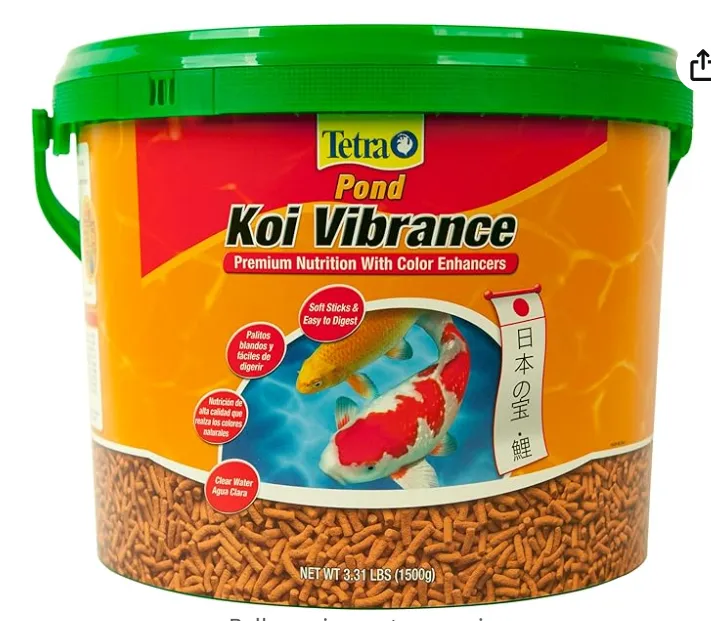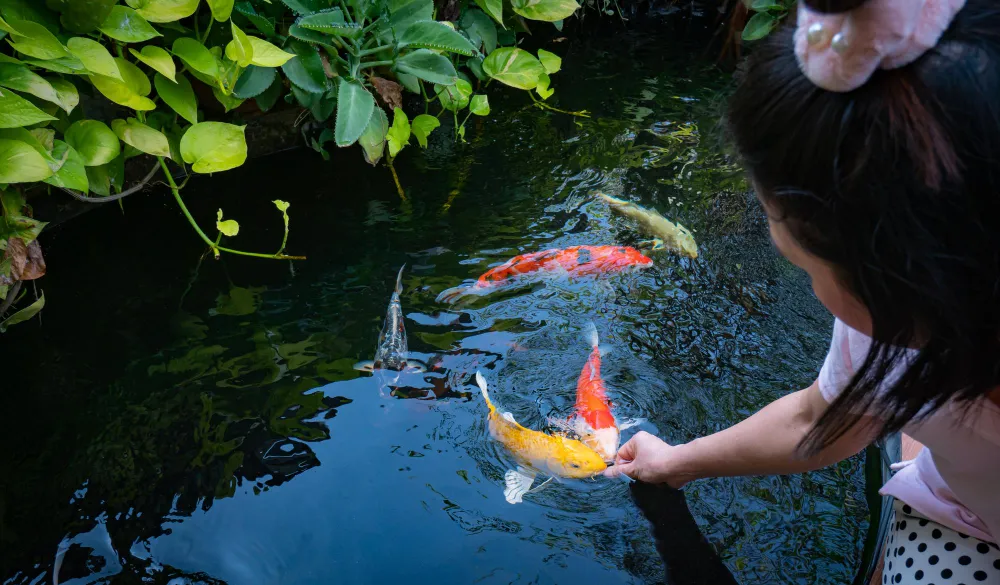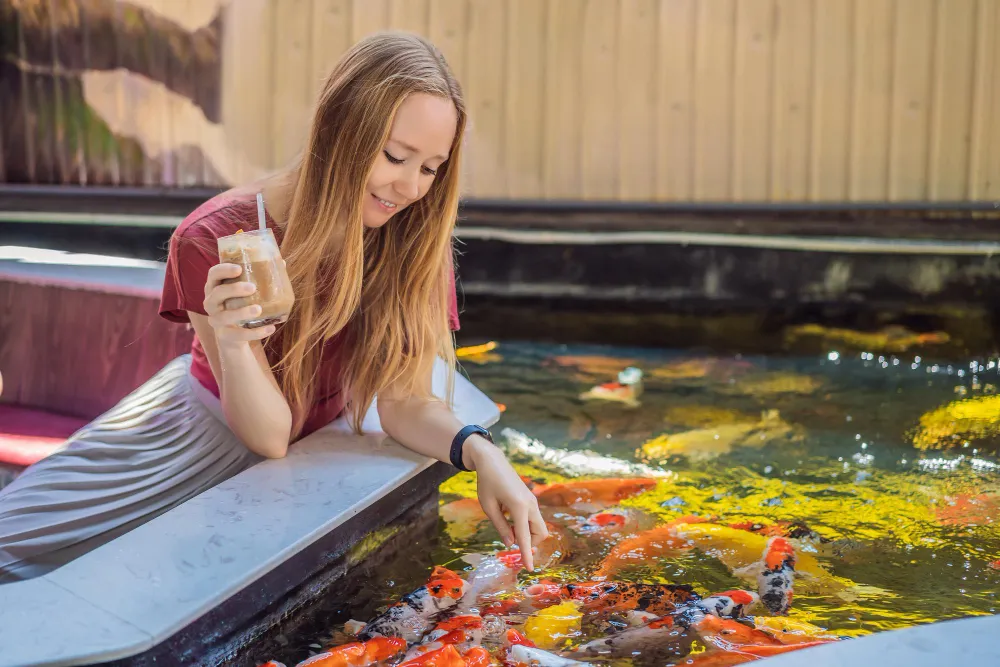
What Do Koi Fish Eat? The Ultimate Guide for Koi Enthusiasts

Introduction What do koi fish eat
What do koi fish eat, Koi fish are more than just stunning ornamental fish swimming gracefully in backyard ponds—they are living jewels that require the right care to thrive. One critical aspect of koi care is their diet. What do koi fish eat? This guide dives deep into everything you need to know about koi fish nutrition, from their natural dietary habits to seasonal feeding practices. By the end, you’ll know exactly how to keep your koi healthy, vibrant, and growing strong.
Understanding Koi Fish Diets
Natural Feeding Habits
In their natural habitats, koi fish are opportunistic omnivores. They feed on a wide variety of food sources, including:
- Insects
- Larvae
- Small crustaceans
- Algae
- Aquatic plants
This diversity ensures that koi get a balanced mix of proteins, fats, and fibers essential for their well-being.
Nutritional Needs of Koi Fish
For optimal health, koi fish need a balanced diet that includes:
- Proteins: Support growth and repair. Essential for younger koi.
- Carbohydrates: Provide energy.
- Fats: Aid in energy storage and temperature regulation.
- Vitamins and Minerals: Ensure overall health and immunity.
A balanced diet ensures your koi’s longevity, vibrant colors, and active behavior.
Types of Food Koi Fish Eat
Commercial Koi Food
Pellets: The most popular choice for koi owners, pellets are convenient and nutritionally balanced. They are available in various formulations, including growth, maintenance, and color-enhancing varieties.
Flakes: Ideal for smaller koi or young fry. Flakes are easy to digest but can disintegrate quickly in water.
Natural Food Options
Insects and Larvae: Koi fish love munching on insects like beetles, mosquito larvae, and dragonfly nymphs. These are protein-rich and mimic their natural diet.
Worms and Crustaceans: Earthworms, mealworms, and shrimp provide essential nutrients like protein and fatty acids.
Algae: A natural staple in their habitat, algae supply fiber and nutrients while helping maintain water quality.
Homemade Koi Food
Fruits:
- Apples
- Oranges
- Watermelon
These fruits are not only delicious but also packed with vitamins. Always remove seeds and offer in small portions.
Vegetables:
- Lettuce
- Spinach
- Peas
Vegetables are great for fiber and are easy for koi to digest. Blanch them for easier consumption.

Feeding Guidelines
How Often Should Koi Be Fed?
The frequency depends on water temperature and the season:
- Summer: Feed 2-4 times daily when koi are most active.
- Spring and Fall: Reduce feeding to once or twice a day as their metabolism slows.
- Winter: Avoid feeding below 50°F (10°C), as koi’s digestive systems enter dormancy.
How Much Food Do Koi Fish Need?
Feed only what they can consume within 5 minutes. Overfeeding can lead to:
- Water pollution
- Bloating
- Uneaten food decomposition
Seasonal Feeding Tips
Feeding in Summer
During the warmer months, koi are most active. Opt for high-protein diets to support energy and growth. Look for ingredients like fish meal and soybean meal in commercial food.
Feeding in Winter
In cold weather, koi’s metabolism slows. Switch to wheat germ-based foods, which are easier to digest. Alternatively, stop feeding altogether if temperatures drop significantly.
Transitioning in Spring and Fall
As temperatures rise or fall, gradually adjust their diet to avoid stress. Transition from high-protein to maintenance food over several days.
Foods to Avoid
Harmful Substances
Not all human foods are safe for koi. Avoid:
- Bread
- Crackers
- Sugary snacks
- Dairy products
These can cause digestive problems and deteriorate water quality.
Risks of Overfeeding
Overfeeding not only wastes food but also creates excessive waste, leading to:
- Ammonia spikes
- Algae blooms
- Poor water clarity
Special Diets for Koi Fish
Enhancing Colors
For vibrant red, orange, and yellow hues, incorporate carotenoid-rich foods like:
- Spirulina
- Shrimp
- Paprika
Promoting Growth
Young koi need higher protein levels (up to 40%). Feed growth-specific pellets to maximize their size and health.
Feeding Koi Fish in a Pond
Pond Environment Considerations
Before feeding, check:
- Water quality
- Oxygen levels
- Temperature
A healthy pond environment ensures your koi’s appetite and digestion remain optimal.
Floating vs Sinking Food
Floating Food: Allows you to observe how much your koi eat and monitor their health.
Sinking Food: Better for shy koi or those at the bottom of the pecking order.
Common Feeding Mistakes to Avoid
- Feeding Too Much: Leads to waste buildup and pond pollution.
- Ignoring Dietary Variety: Monotony can result in nutritional deficiencies.
- Feeding at the Wrong Time: Feed during daylight hours when koi are most active.
- Using Expired Food: Nutrients degrade over time, making old food less effective.
Monitoring Koi Fish Health What do koi fish eat
Signs of Overfeeding
- Cloudy water
- Bloated koi
- Excess food debris
Signs of Malnutrition
- Dull colors
- Lethargy
- Slow growth
Regular observation ensures you catch issues early and adjust their diet accordingly.
Conclusion What do koi fish eat
Feeding koi fish is an art and a science. By understanding their nutritional needs, offering variety, and adjusting their diet to match the seasons, you’ll ensure they thrive in health and beauty. Remember, a happy koi is a well-fed koi.
FAQs What do koi fish eat
1. Can koi fish eat bread?
No, bread can harm their digestive system and pollute the pond.
2. What fruits can koi fish eat?
Koi love fruits like oranges, apples, and watermelon in moderation.
3. How do I know if I’m feeding my koi the right amount?
Feed only what they can eat in five minutes and observe their behavior.
4. Can baby koi eat the same food as adults?
Baby koi require smaller, higher-protein diets to support their growth.
5. What should I do if my koi stop eating?
Check the water quality and temperature, as these factors often impact appetite.
You may also like
- https://giobelkoicenter.com/what-does-the-koi-fish-represent/
- https://giobelkoicenter.com/koi-fish-sickness-symptoms/
- https://giobelkoicenter.com/caring-for-butterfly-koi/
- https://giobelkoicenter.com/how-to-transport-large-koi/
- https://giobelkoicenter.com/understanding-koi-fish-size/
Table of Contents
Passionate about fish keeping since elementary school in the 1980s, Giovanni Carlo has dedicated countless hours to collecting and breeding a diverse array of ornamental freshwater fish. From vibrant guppies and majestic koi to striking bettas and classic goldfish, he continues to explore the fascinating world of aquatics, sharing knowledge and enthusiasm with fellow fish enthusiasts.